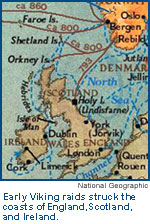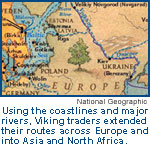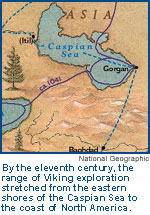
|
"The Wrath of the Northmen": The Vikings and their Memory
by Christina von Nolcken
 ou won't be surprised that the Vikings were normally viewed by those they came up against in a markedly negative light. Certainly this was true in England, the area most of our early records come from, and the one I am most familiar with. Indeed, the story of the Vikings is usually taken--and not just by English historians--as starting and ending with events in England. The end is often considered to be the 1066 invasion of England by the Normans (originally Vikings themselves who had settled in northern France and adopted the language they found there), though Viking-type raids continued, especially in the Scottish islands, until about the end of the twelfth century. ou won't be surprised that the Vikings were normally viewed by those they came up against in a markedly negative light. Certainly this was true in England, the area most of our early records come from, and the one I am most familiar with. Indeed, the story of the Vikings is usually taken--and not just by English historians--as starting and ending with events in England. The end is often considered to be the 1066 invasion of England by the Normans (originally Vikings themselves who had settled in northern France and adopted the language they found there), though Viking-type raids continued, especially in the Scottish islands, until about the end of the twelfth century.
 The beginning of the Vikings' recorded story--which coincides with the beginning of recorded history for Norway--is usually marked by a Viking raid on a northern English monastery in 793. But 793 wasn't quite the first time the Vikings had caused trouble in England. Here is the entry for 787 in the Anglo-Saxon Chronicle, a work only compiled some century later, though it does seem to have used earlier written sources.
The beginning of the Vikings' recorded story--which coincides with the beginning of recorded history for Norway--is usually marked by a Viking raid on a northern English monastery in 793. But 793 wasn't quite the first time the Vikings had caused trouble in England. Here is the entry for 787 in the Anglo-Saxon Chronicle, a work only compiled some century later, though it does seem to have used earlier written sources.
787 [789]. In this year [ . . .] came first three ships of Norwegians from Hørthaland [around Hardanger Fjord]: and then the reeve rode thither and tried to compel them to go to the royal manor, for he did not know what they were: and then they slew him. These were the first ships of the Danes to come to England. (Garmonsway, 55)
What is so striking is the total unexpectedness of this happening. The reeve had expected to find peaceful traders who would take their goods to the royal residence, as was customary. And what he got was people who lived by totally different rules.
The event provides a fitting overture for the even more shocking raid in 793. Here is the relevant part of the Chronicle entry for that year:
In this year terrible portents appeared over Northumbria, and miserably frightened the inhabitants: these were exceptional flashes of lightning, and fiery dragons were seen flying in the air. A great famine soon followed these signs; and a little after that in the same year on 8 [June] the harrying of the heathen miserably destroyed God's church in Lindisfarne by rapine and slaughter. (Garmonsway, 55, 57)
It is an event that terrorized the whole of the Western Christian world. This is what one Englishman (Alcuin of York) had to say about it at the time:
Lo, it is nearly 350 years that we and our fathers have inhabited this most lovely land, and never before has such terror appeared in Britain as we have now suffered from a pagan race, nor was it thought that such an inroad from the sea could be made. Behold the church of St. Cuthbert spattered with the blood of the priests of God, despoiled of all its ornaments; a place more venerable than all in Britain is given as a prey to pagan peoples. [. . .] What should be expected for other places, when the divine judgment has not spared this holy place? (Loyn, 55-6)
Well, what could they expect apart from a lot of trouble? The reach of the raidsThese raiding peoples emerge out of all three Scandinavian homelands--Norway, Sweden, and Denmark--sending off their young men all over the known world in search of wealth and prestige. The Norwegians kept pushing west, sometimes merely raiding, sometimes also setting up settlements, to the Scottish islands, to Ireland (Dublin was founded as a base particularly for slave trading in 841), to northern England. They occupied the Faeroe Islands (825), Iceland (ca. 870-930), and parts of Greenland (ca. 985), finally setting up outposts also in America (ca. 1000). They pushed south through England, into France, down to the Mediterranean.
 The Danes expanded westwards along the North Sea coast toward France. They fanned out within France--Paris was sacked in 845 and again in the 860s--and went south to raid in Spain. Pressing through the straits of Gibraltar and into the Mediterranean, they sacked Luna, a small town in northern Italy, apparently thinking it was Rome (860). They almost completely took over England in the ninth century (with a bit of help from the Norwegians) and, in a later wave of invasion, they provided England's kings from 1013-1035: Swein Forkbeard, Harald II and Cnut.
The Danes expanded westwards along the North Sea coast toward France. They fanned out within France--Paris was sacked in 845 and again in the 860s--and went south to raid in Spain. Pressing through the straits of Gibraltar and into the Mediterranean, they sacked Luna, a small town in northern Italy, apparently thinking it was Rome (860). They almost completely took over England in the ninth century (with a bit of help from the Norwegians) and, in a later wave of invasion, they provided England's kings from 1013-1035: Swein Forkbeard, Harald II and Cnut.
The Swedes traded and colonized around the Baltic. They sailed up Russia's rivers and became the first rulers of the Kievan Russian state. They made their way to Constantinople and the Orient. They served as the bodyguards of the Byzantine emperors. And they certainly did not do all these things without terrorizing a lot of people. As Priit J. Vesilind put it in his "In Search of Vikings" in the May 2000 issue of National Geographic, "In a casually brutal age Vikings were simply better brutes" (Vesilind, 10-11).  The English might not have agreed with Vesilind's assessment of the age, but they would have agreed with him about the Vikings. Following those traumatizing early raids there was a lull for about a generation. But then there were two further waves of attack. The first involved large groups of Danes coming sometimes for loot but also very often to settle in England's green and pleasant land. By the end of the ninth century it seemed they would take over the whole country. The tide was finally turned by King Alfred and his successors, but then there was a second major wave of attacks, heralded by a terse entry in the Chronicle under 981: "In this year for the first time seven ships came and ravaged Southampton" (Garmonsway, 125). And then the English paid, and paid, and paid to try to keep the invaders from laying waste the country--and still they were often plundered.
The English might not have agreed with Vesilind's assessment of the age, but they would have agreed with him about the Vikings. Following those traumatizing early raids there was a lull for about a generation. But then there were two further waves of attack. The first involved large groups of Danes coming sometimes for loot but also very often to settle in England's green and pleasant land. By the end of the ninth century it seemed they would take over the whole country. The tide was finally turned by King Alfred and his successors, but then there was a second major wave of attacks, heralded by a terse entry in the Chronicle under 981: "In this year for the first time seven ships came and ravaged Southampton" (Garmonsway, 125). And then the English paid, and paid, and paid to try to keep the invaders from laying waste the country--and still they were often plundered.
Unfortunately, the English made some very serious mistakes in this later period. In 1002 they indulged in what looks like a stupid effort at ethnic cleansing:
1002. In this year the king and his councillors decided to pay tribute to the fleet and to make peace, on condition they ceased from their evil deeds. [. . .] This was accepted and they were paid twenty-four thousand pounds. Then [. . .] in the same year the king gave orders for all the Danish people who were in England to be slain on St. Brice's day [13 November], because the king had been told that they wished to deprive him of his life by treachery, and all his councillors after him, and then seize his kingdom. (Garmonsway, 133-5)
Among those slain was the sister of Swein Forkbeard, king of Denmark. The act provoked Swein to an orgy of revenge that reached its climax in 1011--at least according to our monastic chronicler--when the Vikings plundered Canterbury and seized all those in holy orders, including the archbishop Ǽlfhere. The following year they martyred him:
1012. Then on the Saturday the host became greatly incensed against the bishop, because he was not willing to offer them any money, and forbade any ransom to be given for him. Moreover they were very drunk, for wine had been brought to them from the south. Then they took the bishop, and led him to their tribunal, on Saturday evening, within the octave of Easter [19 April], and pelted him to death with bones and the heads of cattle; and one of them smote him on the skull with the iron [head] of an axe, so that with the blow he sank down and his holy blood fell upon the earth, and his holy soul was sent forth to God's kingdom. (Garmonsway, 142)
It seemed to the English that the world was coming to an end. Picturing the VikingsThe English weren't the only ones who lived in fear of the Vikings. The French too were traumatized: "From the wrath of the Northmen, O Lord, deliver us," they prayed. And at the other end of the known world the Arabs were simply appalled. Ibn Fadhlan, an Arab emissary who met a group of Vikings in the 920s, described them as "the filthiest of Allah's creatures: they do not wash after shitting or peeing, nor after sexual intercourse, and do not wash after eating. They are like wayward donkeys" (Roesdahl, 34). Elsewhere he provides a detached but terrifying eyewitness account of a Viking ship burial on the Volga (I provide a conveniently abbreviated version of this; I quote at such length because the account is so astonishing):
When a chieftain dies, slaves and servants are asked who will die with him. The one who volunteers cannot alter the decision. In this particular case it was a woman who was treated with great courtesy while the burial was being prepared. On the day of the funeral the chieftain's ship was drawn up on land and people walked around it and said words. A bier was placed on it and cloths and cushions laid on it by an old woman called the Angel of Death. She was responsible for the preparations. The dead body which up to now had been laid in a grave was taken up and dressed in splendid garments specially made for the occasion. He was seated among the cushions in the tent on the ship, with alcoholic drink, food, aromatic herbs and all his weapons. Then a dog, two horses, two cows, a cock and a hen were killed and placed in the ship. The woman who was to die went round to each tent in the camp and had sexual intercourse with its owner. After this she performed various other rituals. She was raised three times above something which looked like a door frame and said: "I see my master sitting in paradise, and it is beautiful and green and with him are men and slaves [or youths] and he calls me. Lead me to him." Then she killed a hen and was taken to the ship, took off her jewellery, drank two beakers and sang, and was finally taken into the tent to her dead master by the Angel of Death. Six men followed her into the tent and had sexual intercourse with her, then she was killed. The closest relatives of the deceased now lit the firewood under the ship. Others threw more flaming brands on the fire and within one hour everything was burnt. Then they built a mound on the spot and raised a pole at its centre with the name of the chieftain and his king on it, and went away. (Roesdahl, 157)
This picture of the Vikings as primitive, ruthless, and often revolting marauders comes, of course, mainly from their victims, though it is corroborated by onlookers like Ibn Fadhlan. It is also relatively well known to us; it has, for example, helped inspire some striking artwork. But it is not a picture that has enjoyed any kind of continuous existence, even among the descendants of the people the Vikings traumatized.Let me elaborate very briefly on this point, as it is quite fascinating to follow the different ways in which the Vikings have been perceived in the centuries separating them from our own (here I draw my information mainly from Lars Lönnroth's chapter in Sawyer's Oxford Illustrated History of the Vikings). For a while, it seems, the Vikings were largely forgotten except within Scandinavia itself. There, and especially in Iceland, they were remembered as glorious warriors and explorers, inhabitants of a kind of golden age, until about the end of the fourteenth century. Then they began to be downplayed even in Scandinavia by historians anxious to claim a place for their countries in the civilized world. Only in the late eighteenth century did they come into their own again, this time in a thoroughly romanticized form, as the ultimate in Noble Savages. As such, they were caught up by various nationalistic movements--by the Gothic Society in Stockholm, for example, that consisted of academics and military personnel drinking from horns and reciting Nordic poetry in the hope this would help the country in its struggles against Russia, or by Danish schoolmasters wanting to replace the study of Latin with Old Norse. As we move into the nineteenth century we also increasingly find the Vikings again making their mark abroad. Most notoriously, they did this in nineteenth-century Germany, where Old Norse and early Germanic mythology achieved a new religious significance in the hands of Richard Wagner (1813-83). Things took a dangerous turn when such ideas began merging with Nietzsche's philosophy of superman, giving rise to the various racist ideas of German supremacy that culminated in the horrors of World War II. A strong anti-Viking reaction almost immediately followed. The Vikings were not entirely forgotten after World War II, but they certainly stopped being lionized. Instead, they were turned into the comic anti-heroes of popular culture--ones like Hagar the Horrible. And while this was happening the scholars--here assisted by developments in archaeology--were busy downplaying the Vikings' activities as fighters and concentrating instead on their activities as traders and on how they regularly settled down as highly respectable farmers--and took rather more baths than our Arab commentator indicates. These sanitized Vikings are, on the whole, the Vikings we are mainly familiar with today. In the aftermath of the millennial anniversary of the Vikings' discovery of America, however, things seem ripe for change. For in several of the publications marking this anniversary--and here I am thinking especially of some accompanying art work--we see the Vikings coming into their own once again as fighters, and larger-than-life ones at that. It is a picture that would have been all-too-familiar to their medieval contemporaries. For a list of sources cited in this article, click here.
ABOUT THE AUTHOR |
Christina von Nolcken
 Christina von Nolcken studied in England at Oxford University, where she specialized in Medieval English Language and Literature. After teaching for three years at St. Anne's College, Oxford, she moved to the University of Chicago where she is associate professor in the Department of English and the College and chair of the Committee on Medieval Studies. She regularly teaches courses on Old and Middle English language and literature and the history of the English language. Most of her writing has been on texts prepared by the followers of John Wyclif (d. 1384) as part of their program to bring education, and especially religious education, to the people. Christina von Nolcken studied in England at Oxford University, where she specialized in Medieval English Language and Literature. After teaching for three years at St. Anne's College, Oxford, she moved to the University of Chicago where she is associate professor in the Department of English and the College and chair of the Committee on Medieval Studies. She regularly teaches courses on Old and Middle English language and literature and the history of the English language. Most of her writing has been on texts prepared by the followers of John Wyclif (d. 1384) as part of their program to bring education, and especially religious education, to the people.
COPYRIGHT | A version of this article was delivered as a lecture at the October 2000 Humanities Open House at the University of Chicago. Copyright 2001 The University of Chicago.
|
 ou won't be surprised that the Vikings were normally viewed by those they came up against in a markedly negative light. Certainly this was true in England, the area most of our early records come from, and the one I am most familiar with. Indeed, the story of the Vikings is usually taken--and not just by English historians--as starting and ending with events in England. The end is often considered to be the 1066 invasion of England by the Normans (originally Vikings themselves who had settled in northern France and adopted the language they found there), though Viking-type raids continued, especially in the Scottish islands, until about the end of the twelfth century.
ou won't be surprised that the Vikings were normally viewed by those they came up against in a markedly negative light. Certainly this was true in England, the area most of our early records come from, and the one I am most familiar with. Indeed, the story of the Vikings is usually taken--and not just by English historians--as starting and ending with events in England. The end is often considered to be the 1066 invasion of England by the Normans (originally Vikings themselves who had settled in northern France and adopted the language they found there), though Viking-type raids continued, especially in the Scottish islands, until about the end of the twelfth century.


 Christina von Nolcken studied in England at Oxford University, where she specialized in Medieval English Language and Literature. After teaching for three years at St. Anne's College, Oxford, she moved to the University of Chicago where she is associate professor in the Department of English and the College and chair of the Committee on Medieval Studies. She regularly teaches courses on Old and Middle English language and literature and the history of the English language. Most of her writing has been on texts prepared by the followers of John Wyclif (d. 1384) as part of their program to bring education, and especially religious education, to the people.
Christina von Nolcken studied in England at Oxford University, where she specialized in Medieval English Language and Literature. After teaching for three years at St. Anne's College, Oxford, she moved to the University of Chicago where she is associate professor in the Department of English and the College and chair of the Committee on Medieval Studies. She regularly teaches courses on Old and Middle English language and literature and the history of the English language. Most of her writing has been on texts prepared by the followers of John Wyclif (d. 1384) as part of their program to bring education, and especially religious education, to the people.